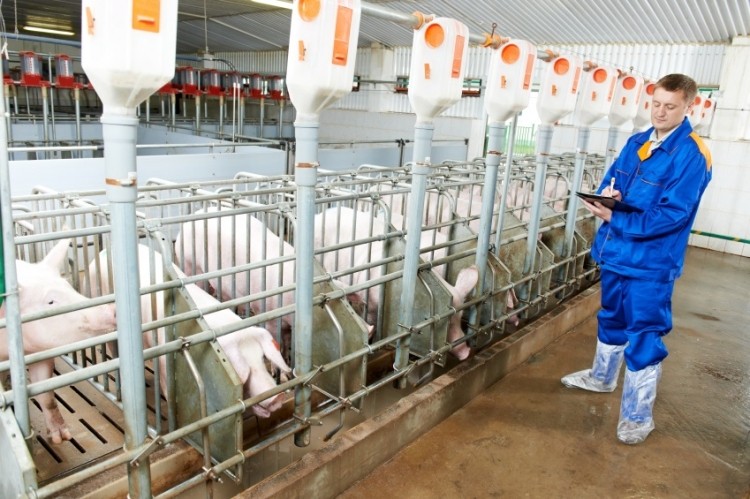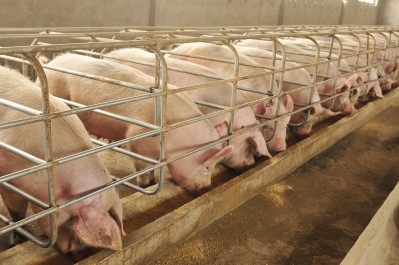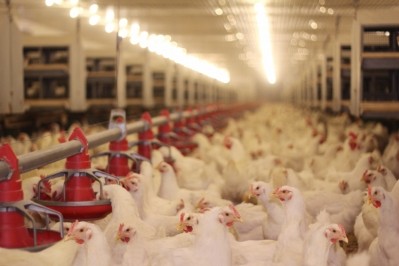US scientists aim at improving feed efficiency in pigs

Researchers with Iowa State University (ISU) compared the way pigs ate and grew when given specific meal times or continual access to feed to examine potential ramifications for feed efficiency and development of lean tissue. The group published their findings in the journal of Physiology and Behavior.
The study was designed to look at improving feed efficiency along with nutrient utilization and animal behavior and welfare, said lead researcher Nicholas Gabler, associate professor of animal science at ISU.
“If you alter the feeding sequencing, there’s the potential to change body compositions or weight gain,” he told FeedNavigator. “What we wanted to do was to devise a project, [to see] if we alter the ways we deliver the meal to a pig, can we improve its efficiency of how it utilizes the nutrients?”
One consideration was if pigs had a longer time to digest between meals, would they get more nutritional benefit from the food they ate, he said. “The biggest issue is feed intake, whether it’s hot days or health challenges, they don’t eat as much [so] they don’t grow as much – there’s opportunity there,” he added.
“Although feed regimen did not alter feed efficiency, these data indicate that twice daily feeding reduced gilt adiposity and growth without altering the pig's behavioral expression of hunger,” said the researchers in the report. “Therefore, twice daily feeding may be a method of increasing percent of lean tissue without negatively impacting gilt welfare.”
Diet methods
One goal of swine production is to improve the development of lean tissue, said the researchers. However, in the US many swine producers use ad libitum feeding – allowing animals continual access to food – for a grow-finish system.
Restricted diets like drop feeding or using electronic feeders are more common for specific periods like gestating sows, they said.
“While production goals vary across production stages, an overall swine industry goal is to improve feed efficiency and thus profitability,” they said. “Furthermore, animal welfare is an important producer and consumer interest and the impact of feed management on pig hunger is a primary concern.”
In an ad libitum system, pigs visit the feeder differing numbers of times, said the researchers. Pigs genetically selected for feed efficiency tend to feed less often.
However, studies examining use of altered feeding patterns have generated conflicting results in terms of feed efficiency and body composition, they said. And, few studies have examined nutrient utilization and growth with feeding regime.
“The objective of this study was to compare two feeding patterns and to evaluate their impact on gilt nutrient utilization and whole body tissue accretion, feeding behavior and activity,” they said. “Our second objective was to relate gilt feeding behavior and activity to nutrient utilization and whole body tissue accretion.”
Experiment details
In the experiment, 48 female pigs were individually housed and assigned one of two feeding regiments for a period of seven weeks, said the researchers. One group was allowed continuous access to feed (Feed Access) and the other had two, hour-long feeding periods a day (2X).
Both sets of pigs were given the same corn-soybean mash diet during the experiment, they said.
Performance was recorded every week and average daily gain (ADG), average daily feed intake (ADFI) and the gain to feed ratio (G:F) were determined, they said. A selection of pigs was x-rayed to determine body composition on days 3 and 55.
Pig behaviors also were assessed to track time eating, feeding rate, postural changes, interaction with items in their pens, and standing, sitting and lying behaviors, they said.
Results
“Originally we thought we’d see an increase in efficiency or body performance but we didn’t see that,” said Gabler.
There were some takeaways for producers, he said, such as the production system did not generate negative behavior in the pigs. But Gabler said more work needs to be done to better understand nutrient utilization and the role it plays with feed efficiency.
No overall difference in the gain to feed ratio was found between the two groups, said the researchers. However, pigs getting the 2X diet had both reduced ADG and ADFI intake compared to control pigs.
“At day 55 gilts fed 2X had a lower fat:protein compared to Free Access gilts,” they said. “Fat, lean, and protein accretion rates were lower in gilts fed 2X compared to those fed Free Access.”
Pigs on the free access diet had higher body weights weeks 3-7 and higher ADFI for weeks 1,2 and 4, they said. But, 2X pigs had greater ADG for week 6.
Pigs getting the diet at specific times of day ate less overall, they said. But those animals also spent more time interacting with items provided in their pens and did not appear to increase “behavioral expression of hunger.”
Whole body compositions were similar for the treatments, said the researchers, but those on the 2X diet had less fat, less lean and less protein overall.
“Twice daily feeding reduced the fat to protein ratio,” they said. “As this is a US grow-finish swine production goal, twice daily feeding may have implications for future developments in precision livestock farming.”
Both sets of pigs spent about the same amount of time standing, sitting or lying down, they said. But, pigs on the 2X diet tended to change posture less often.
What’s next?
If similar experiments are run in the future, there are some changes that could be made, said Gabler.
“We kind of missed the mark in what we tried to achieve,” he said. “They just didn’t consume the same calories.”
These include that the pigs could have been given the same amounts of feed in the different feeding systems, he said. “In hindsight we should have had a feeding regime where they had access to a feeder four or six times a day,” he added.
Source: Physiology & Behavior
Title: Daily feeding regimen impacts pig growth and behavior
DOI: doi:10.1016/j.physbeh.2016.03.003
Authors: Jessica Colpoys, Anna Johnson, Nicholas Gabler,








